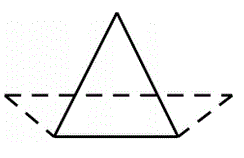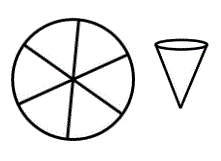
|
Washington State Math Olympiad
Hints and Solutions
2012 Grade 6 Geometry
|
 |
Editor's note: In my opinion, problem #1 is inappropriate for 6th graders. I provide a hint and a (very long) solution, but don't suggest you give this to your students. If you choose to use this problem, cover this comment with a marker.
| Problem |
 1) An isosceles triangle and an isosceles trapezoid
share a common base (solid line) and have the same
area. However the trapezoid has 1/3 the height of
the larger triangle. What fraction of the longer base
of the trapezoid extends outside the triangle?
1) An isosceles triangle and an isosceles trapezoid
share a common base (solid line) and have the same
area. However the trapezoid has 1/3 the height of
the larger triangle. What fraction of the longer base
of the trapezoid extends outside the triangle? |
 2) A three dimensional object can be represented
by different views: looking down from above (top
view), looking from the front (front view), and
looking from the right (right side view). Each
picture only shows what is facing you directly
from that view. What is the fewest number of
cubes that could be in the grouping described by
the three pictures?
2) A three dimensional object can be represented
by different views: looking down from above (top
view), looking from the front (front view), and
looking from the right (right side view). Each
picture only shows what is facing you directly
from that view. What is the fewest number of
cubes that could be in the grouping described by
the three pictures? |
 3) Six paper cones for cotton candy are created from a
circle with radius 6 inches by cutting out pie shaped
pieces that each are one sixth of the circle and then
taping together their edges. What is the radius of the
circular rim of one of the cones if there is no
overlapping when the edges are taped?
3) Six paper cones for cotton candy are created from a
circle with radius 6 inches by cutting out pie shaped
pieces that each are one sixth of the circle and then
taping together their edges. What is the radius of the
circular rim of one of the cones if there is no
overlapping when the edges are taped?
(Drawing not to
scale.) |
|